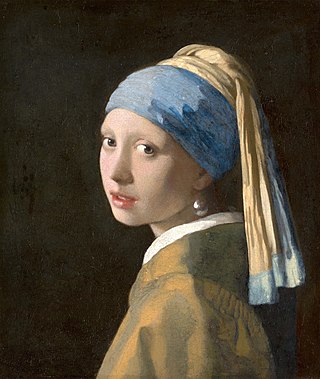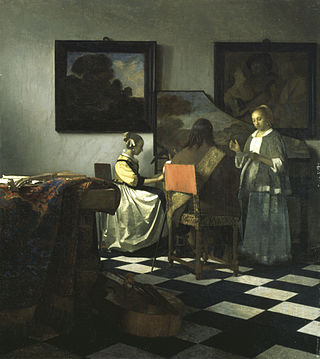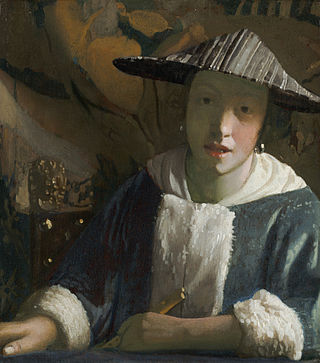Jonathan Janson (born November 10, 1950) is an American painter and art historian.
Jonathan Janson (born November 10, 1950) is an American painter and art historian.
Born in South River, New Jersey [1] and raised in upstate New York and Florida, Janson graduated from the Rhode Island School of Design (Providence, Rhode Island) in 1972 with a major in painting. The turning point in his studies came when in 1969 he visited the Isabella Stewart Gardner Museum in Boston, Mass., where he saw Johannes Vermeer’s "Concert." This small but perfect masterpiece left a profound impression on the emergent painter decisively orienting his artistic direction. In his senior year at R.I.S.D. he studied in Rome, Italy, having been selected for the European Honors Program at Palazzo Cenci.
After a brief return to his home in Florida, Janson returned to Rome (where he continues to live and work until today) to deepen his studies of 17th-century European painting and establish his family. In this period of creative incubation, Janson came to grips with the complexities of organizing detailed, multi-layered figurative painting.
Janson put together a group of small, tightly composed interior paintings and suburban landscapes manifestly inspired by Vermeer in which the artist updated the Dutch painter's motifs of contemporary life. A Roman art dealer organized Janson's first solo show in 1980 which introduced his work to the Italian art public. Shortly after, he began showing with the influential Galleria Forni, Bologna which exposed his work to an international audience. Janson continued to refine his technique while exploring the cultural continuum of Dutch genre themes such as reading, writing, family life and music making.
In 1983, after a summer sojourn in his native Florida, Janson painted a series of minimalist watercolors inspired by the harsh, semitropical environment of the suburban Florida landscape. The most characteristic motifs of this series are devoid of human presence, which, however, is incessantly signaled by cars moving along highways or parked quietly in anonymous strip-mall parking lots or gas stations. These small scenes are characterized by intense backlighting which frames the voids and unnoticed events of America's daily life. The artist's deft touch and two or three color palette draws inspiration from the topographical studies of William Turner and the New England watercolors of Edward Hopper.
In 1984 Janson presented a group of the Florida watercolors in a solo-exhibition at the historical photo-realist O.K. Harris Gallery, New York. In the years which follow, he took part in more than 50 group and 30 solo exhibitions until the most recent in late 2009, a solo-exhibition of Seattle and Florida suburban landscapes unified by a mute gray palette and severe weather conditions. Janson continues to work alternately in the two parallel modes of painting: landscape watercolors and interior oil paintings.
Responding to the internet medium, Janson created a website called Essential Vermeer in 2001. Essential Vermeer has developed into the primary internet resource for Vermeer studies and the most comprehensive website dedicated to a single painter. Essential Vermeer presents a balanced in-depth study of the life, art and cultural milieu of Johannes Vermeer comprising hundreds of web pages, thousands of images, collaborative studies, interviews with Vermeer notables and multi-media features. The site includes a complete interactive catalogue of the Dutch artist which permits the navigator to access extensive information on each work using images mapping and expandable topic boxes. Janson issues a free newsletter which keeps thousands of subscribers informed about Vermeer-related exhibitions, publications and multi-media events.
Janson's commitment has brought the Essential Vermeer to the attention of art historians and specialists in 17th-century Dutch art as well as writers who use it regularly as a reference point. He travels extensively and is in constant contact with museum personnel and art historians involved with Dutch genre painting and specifically with the work of Vermeer.
In 2002, Janson was commissioned by the American Hallmark Hall of Fame to paint a hypothetical Vermeer for the television adaptation Brush with Fate, based on Susan Vreeland's best-selling novel Girl in Hyacinth Blue. It was broadcast on CBS a year after.
In 2009, Janson is featured in a documentary Views on Vermeer: 12 Short Stories by Hans Pool and Koos de Wilt. The film presents influential contemporary painters, writers, photographers, art historians and opinion leaders who unravel the extraordinary and mysterious impact of the 17th century Delft master Johannes Vermeer in our day and age.
In 2006, Janson published his first book, How to Paint Your Own Vermeer: The Methods and Materials of a Seventeenth-Century Master, mainly thought as a manual for practicing painters who wish to emulate the great Dutch Master's technique and style. In addition to the book he produced a CD, How to Paint Your Own Vermeer. A Painting in Progress which documents the painting of an interior done in the style of Vermeer with sequential images that enhance the textual contents of How to Paint Your Own Vermeer.
His second publication, Looking Over Vermeer’s Shoulders. A Study of the Painting Methods and Materials of Johannes Vermeer is an adaptation from the first one, a comprehensible guide to anyone who is interested in exploring the mysterious relationship between painting technique and artistic expression, as well as the mental and physical machinery of Johannes Vermeer, one of the greatest painting technicians of all time.

Johannes Vermeer was a Dutch painter who specialized in domestic interior scenes of middle-class life. He is considered one of the greatest painters of the Dutch Golden Age. During his lifetime, he was a moderately successful provincial genre painter, recognized in Delft and The Hague. He produced relatively few paintings, primarily earning his living as an art dealer. He was not wealthy; at his death, his wife was left in debt.

Brush with Fate is an American drama television film debuted on February 2, 2003, on CBS. It followed the life of an imaginary painting by Dutch painter Johannes Vermeer as it passes through the hands of various people. The film was based on Girl In Hyacinth Blue, the 1999 novel by author Susan Vreeland, and starred Glenn Close and Ellen Burstyn. The imaginary painting Girl in Hyacinth Blue, the principal object in this film, is painted exactly in Vermeer's painting technique by the American master painter Jonathan Janson, author and webmaster of the world-known website about the life and work of Johannes Vermeer "Essential Vermeer".

Frank Weston Benson, frequently referred to as Frank W. Benson, was an American artist from Salem, Massachusetts, known for his Realistic portraits, American Impressionist paintings, watercolors and etchings. He began his career painting portraits of distinguished families and murals for the Library of Congress. Some of his best known paintings depict his daughters outdoors at Benson's summer home, Wooster Farm, on the island of North Haven, Maine. He also produced numerous oil, wash and watercolor paintings and etchings of wildfowl and landscapes.

The Art of Painting, also known as The Allegory of Painting, or Painter in his Studio, is a 17th-century oil on canvas painting by Dutch painter Johannes Vermeer. It is owned by the Austrian Republic and is on display in the Kunsthistorisches Museum in Vienna.

The Milkmaid, sometimes called The Kitchen Maid, is an oil-on-canvas painting of a "milkmaid", in fact, a domestic kitchen maid, by the Dutch artist Johannes Vermeer. It is in the Rijksmuseum in Amsterdam, the Netherlands, which regards it as "unquestionably one of the museum's finest attractions".

Girl with a Pearl Earring is an oil painting by Dutch Golden Age painter Johannes Vermeer, dated c. 1665. Going by various names over the centuries, it became known by its present title towards the end of the 20th century after the earring worn by the girl portrayed there. The work has been in the collection of the Mauritshuis in The Hague since 1902 and has been the subject of various literary and cinematic treatments.

Saint Praxedis is an oil painting by Johannes Vermeer. This attribution has often been questioned. The painting is believed to be a copy of a work by Felice Ficherelli that depicts the early Roman martyr, Saint Praxedis or Praxedes.

The Concert is a painting by the Dutch artist Johannes Vermeer depicting a man and two women performing music. It was stolen on March 18, 1990, from the Isabella Stewart Gardner Museum in Boston and remains missing. Experts believe it may be the most valuable stolen object in the world; as of 2015, it was valued at US$250 million.

Christ in the House of Martha and Mary is a painting finished in 1655 by the Dutch Golden Age painter Johannes Vermeer. It is now in the Scottish National Gallery in Edinburgh. It is the largest painting by Vermeer and one of the very few with an overt religious motive. The story of Christ visiting the household of the two sisters Mary of Bethany and Martha goes back to the New Testament. The work has also been called Christ in the House of Mary and Martha.

Officer and Laughing Girl, also known as Officer and a Laughing Girl, Officer With a Laughing Girl or, in Dutch, De Soldaat en het Lachende Meisje, is an oil painting on canvas executed ca. 1657 by the Dutch artist Johannes Vermeer. Its dimensions are 50.5 by 46 cm. It is now one of three pictures by Vermeer in The Frick Collection in New York.

Girl with a Red Hat is a rather small painting, signed by the Dutch painter Johannes Vermeer. It is seen as one of a number of Vermeer's tronies – depictions of models fancifully dressed that were not intended to be portraits of specific, identifiable subjects. Whether Vermeer chose family members as models or found them elsewhere in Delft is irrelevant to the appreciation of his paintings. Its attribution to Vermeer – as it is on a (recycled) wood panel and not on canvas – has been a matter of controversy with scholars on both sides of the argument. However, in recent study carried out by the curators of National Gallery of Art certainty has been established on the authorship of the painting by Vermeer, a conclusion also supported by Dutch experts.

The Geographer is a painting created by Dutch artist Johannes Vermeer in 1668–1669, and is now in the collection of the Städel museum in Frankfurt, Germany. It is closely related to Vermeer's The Astronomer, for instance using the same model in the same dress, and has sometimes been considered a pendant painting to it. A 2017 study indicated that the canvas for the two works came from the same bolt of material.

View of Delft is an oil painting by Johannes Vermeer, painted c. 1659–1661. The painting of the Dutch artist's hometown is among his best known. It is one of three known paintings of Delft by Vermeer, along with The Little Street and the lost painting House Standing in Delft, and his only cityscape. According to art historian Emma Barker, cityscapes across water, which were popular in the Netherlands at the time, celebrated the city and its trade. Vermeer's View of Delft has been held in the Dutch Royal Cabinet of Paintings at the Mauritshuis in The Hague since its establishment in 1822.

The Procuress is a 1656 oil-on-canvas painting by the then 24-year-old Johannes Vermeer. It can be seen in the Gemäldegalerie Alte Meister in Dresden. It is his first genre painting and shows a scene of contemporary life, an image of mercenary love perhaps in a brothel. It differs from his earlier biblical and mythological scenes. It is one of only three paintings Vermeer signed and dated. In 1696 the painting, being sold on an auction in Amsterdam, was named "A merry company in a room".

Woman with a Pearl Necklace by Johannes Vermeer is a Dutch Golden Age painting of about 1664. Painted in oils on canvas, Johannes Vermeer portrayed a young Dutch woman, most likely of upper-class descent, dressing herself with two yellow ribbons, pearl earrings, and a pearl necklace. As a very popular artist of the 17th century, the Dutch Golden Age, Vermeer depicted many women in similar circumstances within interior, domestic scenes. The same woman also appears in The Love Letter and A Lady Writing a Letter. The painting is part of the collection of the Gemäldegalerie in Berlin.

Mistress and Maid is an oil-on-canvas painting produced by Johannes Vermeer c. 1667. It portrays two women, a mistress and her maid, as they look over the mistress' letter. The painting displays Vermeer's preference for yellow and blue, female models, and domestic scenes. It is now in the Frick Collection in New York City.

The Guitar Player is an oil painting by Dutch Golden Age artist Johannes Vermeer (1632–1675), dated c. 1672. This work of art is one of Vermeer's final artistic activities, providing insight into the techniques he mastered and approaches to painting he favored. The painting has been on display at Kenwood House, London since the 1920s, as part of the Iveagh Bequest collection. After being recovered from a theft in 1974, when the painting was held for ransom, The Guitar Player was returned to Kenwood House.

Girl with a Flute is a small painting by Johannes Vermeer. It is currently believed to have probably been painted between 1669–1675. It is owned by the National Gallery of Art in Washington, D.C. along with three paintings attributed to Vermeer: Woman Holding a Balance, A Lady Writing a Letter, and Girl with a Red Hat.

Johannes Vermeer was a Dutch Baroque Period painter who specialized in domestic interior scenes of middle class life. His works have been a common theme in literature and films in popular culture since the rediscovery of his works by 20th century art scholars.